The 16 Coolest Climbing Gyms in the World
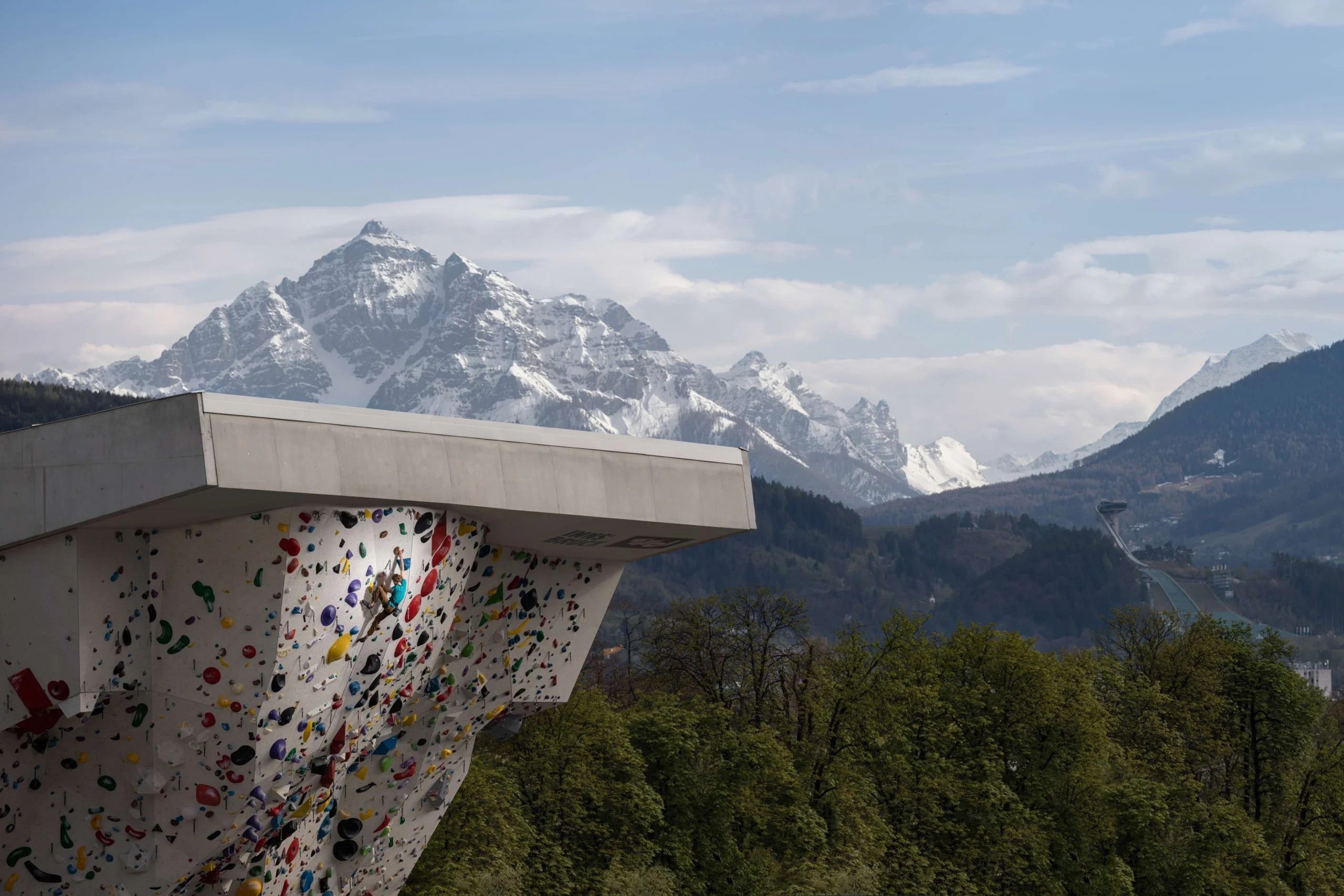
(Photo: © Alpenverein Kletterzentrum Innsbruck GmbH / Alpsolut Pictures)
In the ’80s, ’90s, and much of the early aughts, rock climbing gyms were little more than training grounds where climbers honed their skills in preparation for objectives on real rock. But those days are long gone. Over two percent of the U.S. population has climbed indoors at least once in the last year. A growing subset of regular climbers (as much as 30%, by some estimates) exclusively climb inside. And there are many more for whom outdoor trips are rare vacations from near-daily trips to the plastic.
Despite the moaning of a few old crust kings, the recent proliferation of large, ornate climbing gyms is simply a natural progression of our planet’s growing population and our sport’s growing popularity. It also means that many indoor gyms have become world-class destinations in their own right, as worthy of a visit as many a legendary sport crag or boulder field. Below are 16 of the world’s coolest climbing gyms, in no particular order.
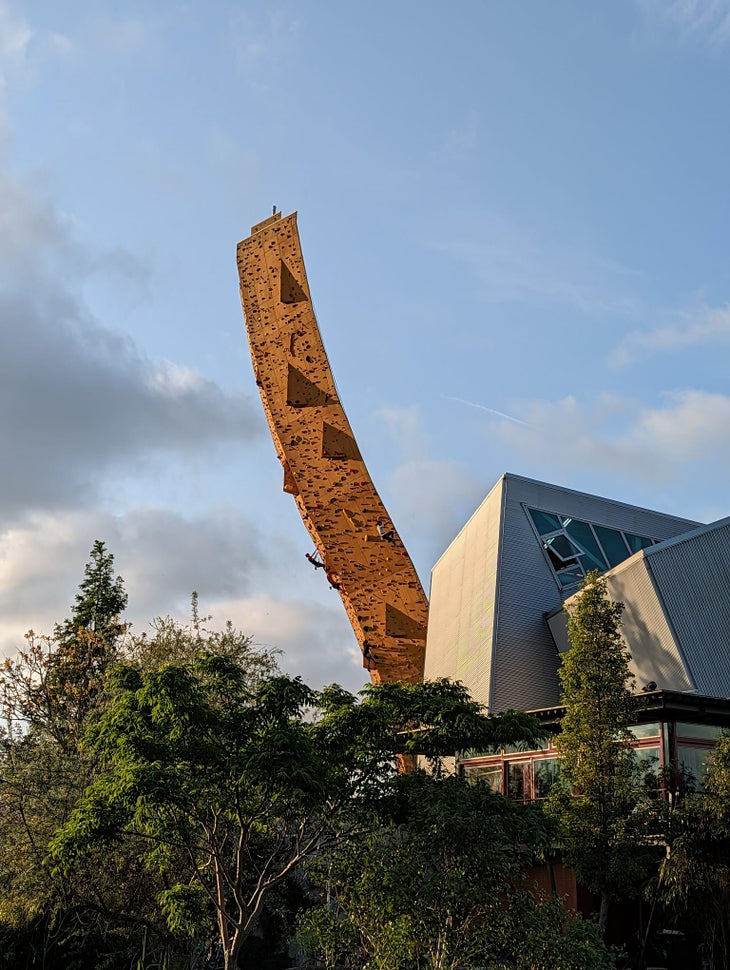
The 16 Coolest Climbing Gyms
1. Kletterzentrum Innsbruck, Austria
We can’t have a list of the best climbing gyms in the world without Kletterzentrum Innsbruck (better known as “KI” for us Americans; looking at that first word gives me anxiety.) This sprawling Innsbruck training center is oft-touted as the world’s best climbing gym, due to the sheer size. Kletterzentrum spans 60,000 square feet of climbing surface—and variety—with over 550 roped routes and 200-plus boulders. The setting is world-class, and it’s also the largest gym ever built in a single push. KI is a must-visit if you’re ever in Innsbruck.
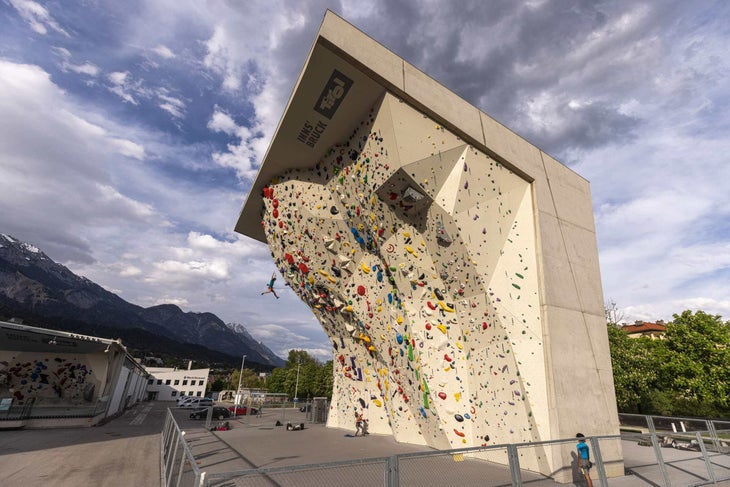
2. B-PUMP Ogikubo, Japan
Japan pumps out fiendishly strong climbers like an assembly line—and when you visit gyms like B-PUMP Ogikubo, it’s easy to understand why. With a rich history dating back to 1993, the B-PUMP chain now operates half a dozen gyms around Tokyo.
Our Picks
The Akihabara location is the largest gym in the country, but the boulder cave Ogikubo is perhaps the most iconic, due to its focus on top-shelf climbing, training, and diverse creative setting. You’ll see no shortage of Japanese IFSC pros on a visit to B-PUMP. Just leave your ego at the door—the problems are notoriously stiff, even for Japan.
3. CATS Gymnastics, Colorado, USA
More modern gyms may outshine the historic Boulder gym CATS (Colorado Athletic Training Center), but it still deserves a place on this list for its history alone. Founded in 1988, CATS is one of North America’s oldest climbing walls. Seattle’s Vertical World edges it out by one year.
Built by gymnast and climber Robert Candelaria, this gym serves as much as a gymnastics training center as it does a bouldering gym. Where climbing is concerned, CATS puts a strong focus on competitive youth training and coaching, as opposed to casual climbing. American crushers from Brooke Raboutou to Daniel Woods have trained here, and pretty much every Colorado-based climber has hit the CATS spray wall at one time or another.
As you can see, the holds are bad, the density is absurd, and the walls are never reset, which means you can test yourself on V14 testpieces that were first climbed decades ago, like Bubble Wrap (V13/14), first sent by Daniel Woods in 2013.
Bubble Wrap from James O’Connor on Vimeo
4. Climb BlueSky, Kenya
East Africa’s first public rock gym, Climb BlueSky in Nairobi, may not have world-class facilities, but it’s noteworthy for the way it’s cultivated our sport, expanding access to climbing in Africa. Bouldering and roped climbing are both available, and the gym offers classes, as well as day trips to crags like Hell’s Gate National Park and the Lukenya Hills. BlueSky also runs an annual climbing competition, JamRock.
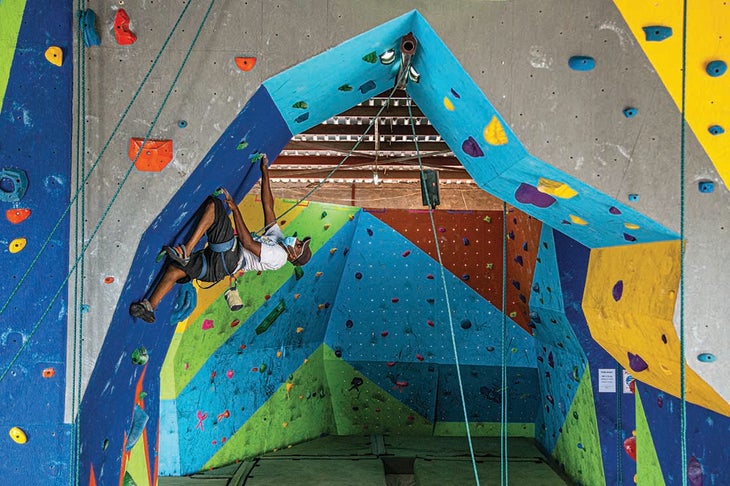
5. CopenHill, Denmark
The 280-foot outdoor wall at CopenHill sits on the side of a building in downtown Copenhagen and is the tallest commercial climbing wall in the world. There are certainly larger artificial walls, like the Luzzone Dam (below), but CopenHill takes the title of tallest “gym” wall out there. The 33-foot-wide wall features five lead climbing lines with two routes per line (10 total). Reaching the top involves climbing four pitches of 65 feet each.
This is no playhouse for newbies, though. A multi-pitch certification is required to climb the CopenHill. Although the easiest route on the wall goes at 5.9, most of the lines are harder, with difficulties up to 5.12c. NOTE: CopenHill has several climbing areas, but as of August 2025, the exterior multi-pitch wall has been temporarily closed, pending a risk analysis. Stay up to date on the gym’s website.
6. Excalibur, Klimcentrum Bjoeks, Netherlands
The eye-catching 121-foot Excalibur spire in the Dutch town of Groningen is often touted as the tallest freestanding climbing structure in the world. (As far as I can tell, this 137-foot tower at Georgia’s Banning Mills actually takes the cake, but for sheer vision and aesthetic value, you can’t beat Excalibur.) The tower’s silhouette is extremely imposing, including 36 extremely overhanging feet at the top. The structure offers both top ropes and lead routes up to 5.13c.

Excalibur is part of the Klimcentrum Bjoeks climbing center, which also has an outdoor boulder park, home to over 200 problems on permanent concrete boulders. Per the Bjoeks website, camping on the grass beneath the tower is free, and you can also spend the night inside the tower by request. The gym has showers and a kitchenette with a microwave and refrigerator. It’s a destination gym if ever there was one.
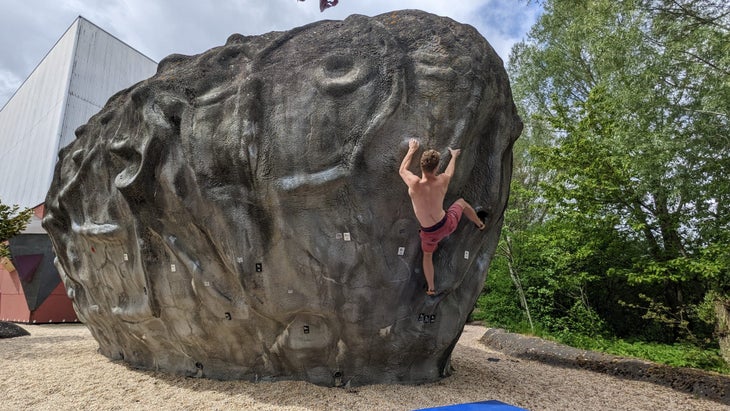
7. Ouray Ice Park, Colorado, USA
Open every winter since 1994, the Ouray Ice Park is the largest human-made ice climbing arena in the world. Host of the legendary Ouray Ice Festival each January, the park houses more than 200 ice and mixed climbing routes along 1.7 miles of the Uncompahgre Gorge.
The ice park is open for around three months each year—usually from mid-December to the end of March, depending on conditions. Amazingly, the park is free for all climbers, though paying members get early access to the park each day and donations are always welcome. Although the park doesn’t offer ice climbing classes, you can find a local guide to take you out or sign up for a clinic during the festivals the park hosts. In short, it’s a great place to pick up the sport if you’ve never climbed ice before.
Related: The Best Ice Parks in the United States

8. The School Room, England
The mysterious English School Room is invite-only, so you and I probably won’t be climbing there any time soon. But as far as gyms go, you’d be hard-pressed to make a case that a better rock den exists anywhere in the world. Almost everyone who was anyone in the UK in the 1990s and 2000s—Ben Moon, Malcolm Smith, Rich Simpson, Stuart Cameron, Jerry Moffatt—cut their teeth here. These days, all-stars like Jim Pope, Molly Thompson-Smith, Aidan Roberts, and Will Bosi still drop in.
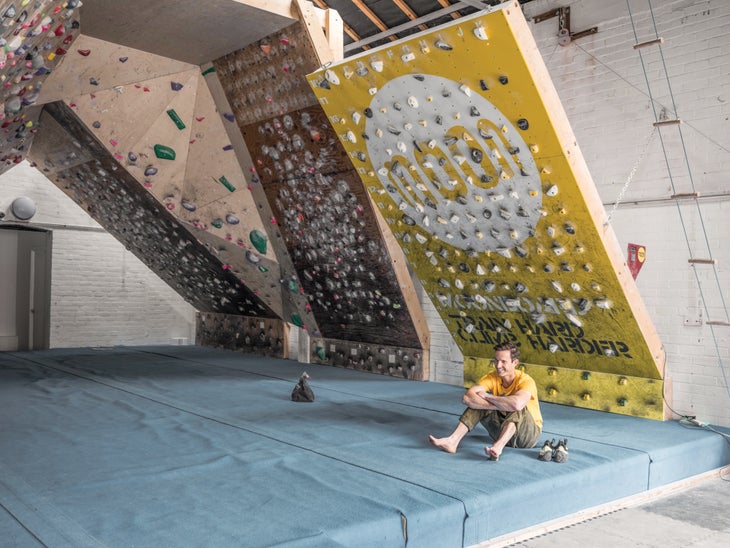
In essence, the School Room was the iron that sharpened British hardmen to go outside and tackle some of the world’s first 5.14s. It was also the birthplace of the legendary MoonBoard. First built in 1993 in the Anns Grove School, the School Room operates today out of a new warehouse space owned by MoonClimbing. If cool for you is a synonym for dingy, tweaky, historic, and hard, this is certainly up there (with CATS) as the coolest gym on the planet.

9. Edinburgh International Climbing Arena, Scotland
Built inside a repurposed quarry near Edinburgh, Scotland, the Edinburgh International Climbing Arena (EICA: Ratho) offers a unique take on indoor climbing, with a tarpaulin-roofed arena that feels like a blend between an outdoor crag and a gym.
In addition to several hundred roped and boulder problems on plastic, 65 rock routes line the exterior of the dolerite quarry, including classics of both trad—Shear Fear (E2 5c/5.10b), Wally 1 (E2 5c)—and sport—The Corrieman (6b+/5.10d), King Silly (7a+/5.12a). Beyond climbing, the “arena” houses a cafe, and also offers aerial assault courses, fitness classes, and a play area for children. Gotta say, climbing outside while in a climbing gym is pretty cool.
Watch climber Avianna Frady talk about the top gyms on this list that she wants to visit
10. Parque de Escalada Los Silos, Chile
The mission of Chilean nonprofit Fundación Deporte Libre (Free Sport Foundation) is to transform abandoned urban spaces into public sports facilities. That’s exactly what they did with two derelict cement factory silos in Santiago de Chile in 2018. Now the “Parque de Silos” is a colorful outdoor climbing gym, with 20 sport routes up to 65 feet high along the walls of the silos, as well as a freestanding boulder with 500 square feet of climbing surface.

It’s free to climb at the Parque de Silos 365 days a year, and the gym also offers free climbing classes and free equipment rental for toproping. Lead climbing is also available, but climbers must bring their own gear. In addition to the Parque de Silos, Fundación Deporte Libre operates 14 other free public parks around Chile, including other climbing walls, a skateboarding park, and a mountain hut on the Calbuco volcano.
Related: Remembering JP Mohr Prieto, the Fundación Deporte Libre co-founder who died on K2


11. Diga di Luzzone, Switzerland
This isn’t a climbing gym, per se, but if you’re looking for audacious artificial climbing, you’d be hard pressed to find a cooler spot than the 541-foot Luzzone Dam, home to the tallest artificial climbing face in the world. The concave dam is scalable via a fully bolted, five-pitch 5.10b, and it costs €20 per climber.
The final couple hundred feet are overhanging, so be prepared for some serious exposure! The bottom of the wall has no holds, you’ll need a ladder (locked up at the base of the climb) to reach them, which you’ll be able to access after paying the fee.
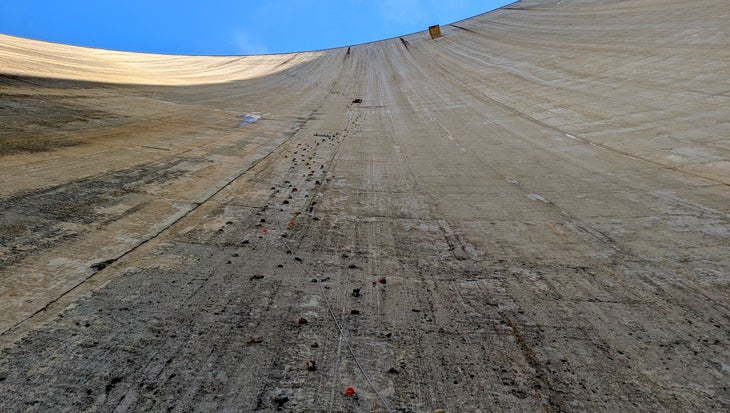
12. Gneis Lilleaker, Norway
This Oslo gym houses 50-foot roped walls, 15 auto belays, and plenty of bouldering and training—but it’s the location that makes it stand out. Gneis Lilleaker’s walls are contained within a large glass atrium looking out on a waterfall and the river Lysakerelven outside. Per YouTuber Magnus Midtbö, Gneis Lilleaker is “the most beautiful climbing gym in the world.”
13. The Cave at CityROCK, Colorado, United States
Housed in a former movie theater, Colorado Springs’ CityROCK is a solid climbing gym in its own right, with 43-foot rope routes up to 5.14 and boulders at V12. However, the caving simulator, dubbed “The Cave,” is something you can’t experience at any other climbing gym in the world.
A 40-foot vertical shaft and 225 feet of cave passages snake around and beneath CityROCK. The goal is to tread lightly. Sensors in the artificial tunnels deduct points if you touch a stalactite or get too close to a cave painting, challenging you to move with a caver’s precision.
14. Area 47, Austria
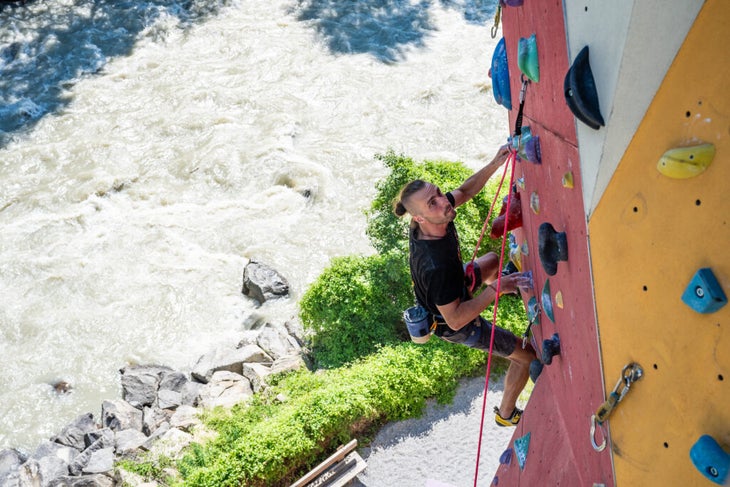
Area 47 in Austria’s Ötztal Valley is a sprawling outdoor adventure park that offers a slew of adventure sports, including rafting, caving, mountain biking, canyoneering, wakeboarding, and bungee jumping. It also has an 88-foot-tall outdoor climbing tower, with routes up to 5.13b. The wall is open from 9:00 a.m. to 9:00 p.m., offers both auto belays and lead routes, and costs just €8.
After a hot morning on the lead wall, climbers can cool off in the park’s “Water Area.” In addition to slides and other waterpark attractions, the water area offers a deep water soloing wall built directly over the lake.
15. Fliegerhalle, Germany
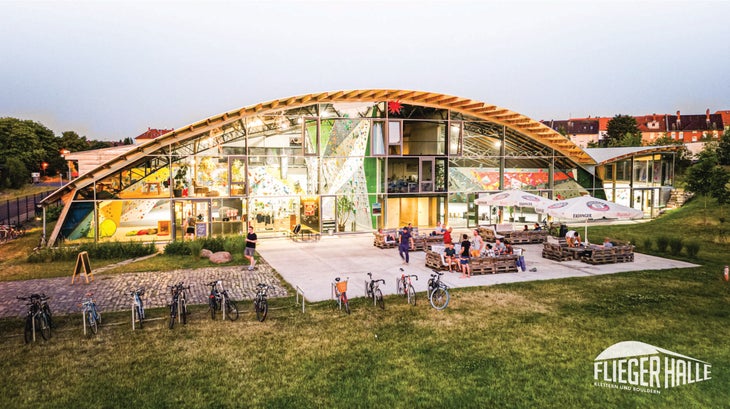
Translating from the German to “aircraft hanger,” Fliegerhalle in the city of Braunschweig is aptly named. Housed inside a massive, semi-cylindrical hangar, the gym is dominated by an enormous, free-standing central arch. While some believe the building was originally a military hangar, the facility’s origins actually remain a mystery to this day. “If anyone can solve the mystery, please get in touch!” a representative of Fliegerhalle told Climbing.
This architectural centerpiece offers a staggering amount of steep, sustained lead climbing and bouldering unlike anything you’ll find at any other gym in the world. It also offers a cool model for other areas—the site is a collab between a commercial climbing gym (Fliegerhalle) and a climbing association (Boulder e.V.). The scale of the space allows for a large quantity of routes and a unique, wide-open atmosphere. Along with the indoor hangar, the property also houses a twin-columned outdoor lead tower and a large freestanding boulder. Currently, an extension to the space is underway, which means even more climbing will be available here in the future.
16. La Cueva, Bolivia
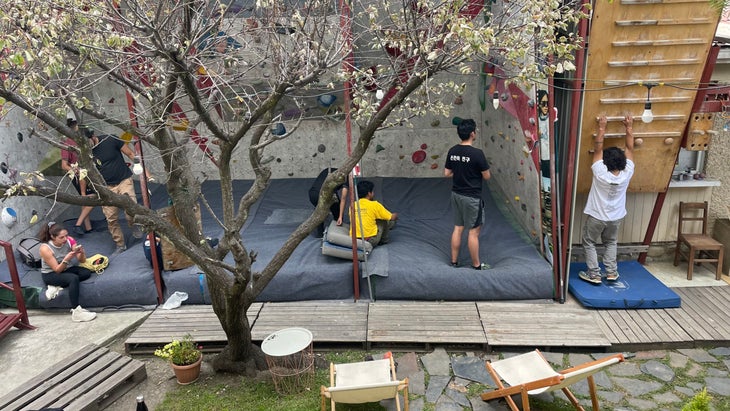
While Bolivia is known for its alpine climbing, plenty of rock climbing exists across this lofty Andean nation, too. Located in La Paz, La Cueva (“The Cave”) has three bouldering walls (two indoor and one outdoor). It’s also the best hub for climbers looking to get out and explore real rock around Bolivia. While the setting and gym itself is nothing to write home about, the location is certainly unique. La Paz sits at an elevation of over 11,900 feet, making it the world’s highest capital city. La Cueva might be the highest elevation climbing gym in the world, so training here presents a real physiological challenge.



